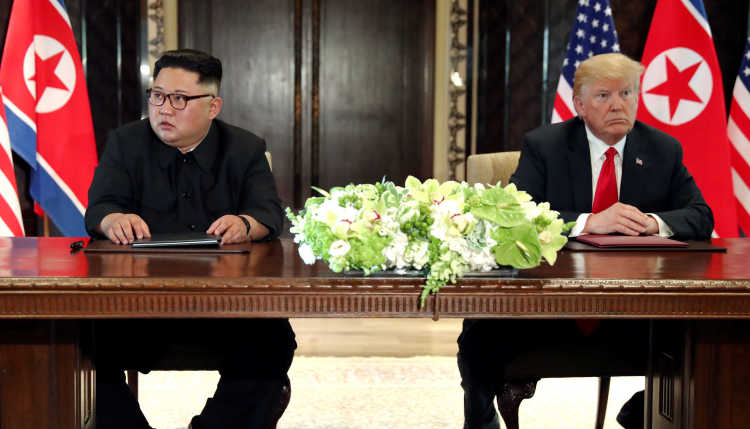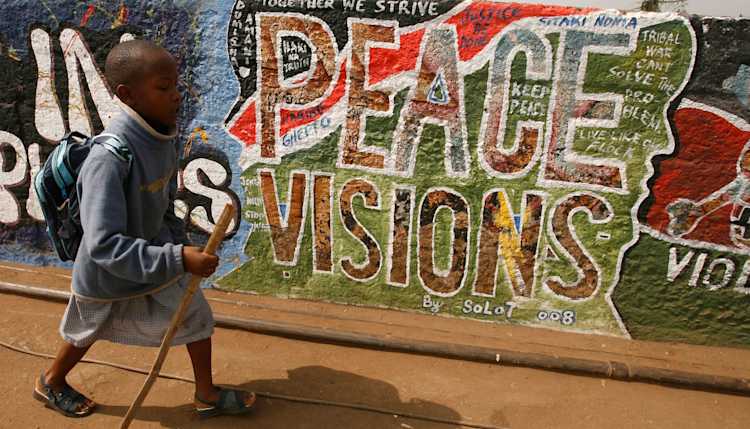- Home
- Publications
- GIGA Focus
- Towards a Global Zero for Nuclear Weapons: Three Lessons from Latin America
GIGA Focus Global
Towards a Global Zero for Nuclear Weapons: Three Lessons from Latin America
Number 3 | 2019 | ISSN: 1862-3581

Full nuclear disarmament and the effective non-proliferation of atomic weapons are two of the most challenging aspirations of humankind. To tackle these issues, most analysts focus on the experiences of nuclear-weapon-owning states. A different perspective is taken here, however, by drawing lessons regarding global non-proliferation and disarmament from one of the most successful cases of compliance worldwide: namely, Latin America.
Today, Latin America is one of the world’s most compliant regions in nuclear non-proliferation and a key advocate of atomic disarmament. It was the first densely populated region in the world to become a nuclear-weapon-free zone; it hosts the only bilateral safeguard agency worldwide; and, it houses large reservoirs of uranium and other fissionable materials.
Historically, nonetheless, Latin America showed variation in state behaviour vis-à-vis nuclear affairs, with some countries being proactive within the non-proliferation regime and others distancing themselves from it. It is, therefore, a relevant case to consider when looking for lessons on global non-proliferation and disarmament.
Three lessons can be drawn from its experience: a broad understanding of confidence-building measures is vital to facilitate lasting trust among countries; institutional creativity is imperative in the nuclear non-proliferation and disarmament realms; and, good communication is crucial to compliance.
Policy Implications
Latin America’s experiences with non-proliferation and disarmament efforts can be applied to Europe, the Middle East, South Asia, and East Asia. Effective nuclear disarmament and non-proliferation depends on creating background conditions for cooperation, trust, and institutions. These elements must lead to a cognitive change in how people understand the nature of nuclear weapons.
Nuclear Power and Non-Proliferation in Latin America
The Treaty on the Non-Proliferation of Nuclear Weapons (NPT) enshrined a “grand bargain” in which nuclear have-nots forwent nuclear arms in exchange for unrestricted cooperation over peaceful atomic technology and on the promise of full nuclear disarmament by nuclear-weapon states. As the NPT’s 50th anniversary approaches in 2020, its agreed promises are yet to be met however. Efforts on nuclear disarmament are at a standstill, and non-proliferation has failed in critical regions such as South Asia (India and Pakistan), the Middle East (Israel and, possibly, Iran), and Europe (where countries rely on the North Atlantic Treaty Organization’s nuclear umbrella).
Most analysists turn to the experiences of nuclear-weapon-owning states when looking at how to fulfil the NPT’s promises. This contribution instead draws lessons from one of the most successful cases of compliance worldwide: Latin America. Because of its achievements in non-proliferation, the spotlight would progressively turn away from Latin America. Its experience, nonetheless, can offer invaluable contributions to other regions, as well as to global efforts with regard to nuclear security. In this contribution, I draw three specific lessons from Latin America for nuclear disarmament and non-proliferation and apply them to specific scenarios worldwide.
Latin America was the first densely inhabited region in the world to become legally free of nuclear weapons. It also houses large reservoirs of fissionable materials, with known uranium deposits in Argentina, Brazil, Colombia, Mexico, and Peru, and possible ones in Guyana and Paraguay too. Policymakers did not overlook these natural capabilities. Seeking to achieve energy security, three Latin American countries succeeded in developing the full scope of nuclear technology for peaceful purposes: Argentina, Brazil, and Mexico. All three are active participants in the global nuclear market, while Brazil is the only non-nuclear-weapon state on the verge of launching a nuclear-powered submarine (by 2029).
In the non-proliferation realm, Latin American countries historically pursued different policies. While countries like Costa Rica and Mexico are traditional upbeat promoters of non-proliferation institutions, and particularly the NPT, Brazil, Argentina, and Chile have meanwhile oscillated between detachment from non-proliferation institutions and decisive participation in them. Detachment came from the understanding that non-proliferation institutions, the NPT especially, were an imposition by superpowers and could block the full development of peripheral states. The nuclear bargain was merely a lie to justify an unequal treaty. Participation in the NPT and other institutions came only in the 1990s; even then, it was conditioned on progress in nuclear disarmament.
Broad Confidence-Building Measures
The first lesson is that cross-thematic cooperation underpins a broader understanding of confidence-building measures. The latter cover the bilateral or multilateral actions that enhance mutual trust, as a means to reduce the fear of attack and thereby halt an arms race. Cross-thematic cooperation means that actions intended to enable talks on nuclear disarmament and non-proliferation should not be restricted to the arms-control realm. They should, instead, involve cooperation efforts in other thematic areas such as economy, trade, and defence too. This inverts the traditional understanding of confidence-building, which advocates that having many things on the table at the same time leads to dissent – and blocks, therefore, possible cooperation.
Having a broad set of economic-, societal-, and security-related issues on the table expands, in fact, the scope of confidence-building measures. This expansion is a most-welcome strategy when it comes to non-proliferation and disarmament because it dilutes the strategic relevance of the possession of nuclear weapons. In Latin America, broad confidence-building measures enabled negotiators to realise that all countries would be better off if money funnelled to an arms race was rather spent on social and economic development instead (Caro 1995:9). In other words, they realised that countries would thrive faster and more sustainably through cooperation rather than through confrontation. Confidence-building measures transcended the nuclear realm and shifted focus to broader targets so as to ensure “peace, democracy and development” (Souza e Silva with Caro 1995: 9). Peace, therefore, was not meant to be achieved alone.
In the Southern Cone, genuine cooperation in the nuclear realm was possible in the late 1980s, after Brazil and Argentina managed to resolve a regional crisis regarding the construction of Itaipu Hydropower Plant and the use of shared river sources. Also crucial was the Brazilian logistic backing to Argentina during the Malvinas War (1982), which was a sign of support against an external opponent. Later confidence-building measures aimed at consolidating good relations between the two countries on a lasting basis. They led to political and economic integration within the framework of the Southern Common Market (Mercosur), and the intensi-fication of defence and diplomatic cooperation. In the nuclear realm, these measures were validated by the creation of the Brazilian–Argentine Agency of Accounting and Control of Nuclear Materials (ABACC).
Europe and the Middle East
A broader concept of confidence-building measures that covers cross-thematic cooperation could also be an enabling condition for non-proliferation and disarmament elsewhere in the world. The first example is Western Europe. Isaac Caro (1995) highlights that, unlike in Latin America, European confidence-building measures in nuclear and arms-control negotiations were systematically dissociated from actions in other areas, such as trade, environment, and defence cooperation. The aim behind this dissociation was to avoid distraction and to give the needed emphasis to the military and security sectors, as historically connected with the transatlantic alliance.
In Western Europe, there are two main approaches to non-proliferation and disarmament. On the one hand, NATO members accept the role of deterrence in their security policies and favour an indeterminate long-term Global Zero solution. They traditionally isolate arms control from other kinds of cooperation efforts, adhering to a restricted understanding of confidence-building measures. On the other hand, nuclear-free countries like Austria favour a more urgent solution to nuclear disarmament efforts. Austria was one of the main supporters of the Humanitarian Initiative leading to the Treaty on the Prohibition of Nuclear Weapons (TPNW), and the country argues that nuclear disarmament should not be separated from parallel efforts because atomic weapons have an insurmountable environmental and humanitarian impact.
A broader understanding of confidence-building measures should incentivise closer cooperation between these two European approaches to non-proliferation and disarmament, leading to joint action. With already well-developed integration in multiple spheres, European countries are in a position to pursue talks leading to a common position on nuclear disarmament and non-proliferation issues. Instead of furthering divisions between the two approaches, European states should focus instead on using existing institutions as a means to achieve a compromise that favours short- and medium-term disarmament. This could be done, for example, by including nuclear disarmament in negotiations on environmental protection and defence cooperation in forums such as those found in the European Union. A further step would be extending cross-thematic cooperation with Russia, perceived as the most likely foe by European states.
A broader understanding of confidence-building measures would also serve nuclear non-proliferation and disarmament efforts in the Middle East. A lack of integration among Middle Eastern countries and interstate rivalries are critical to the partial failure of non-proliferation efforts in the region. Strengthening cooperation in political and economic relations is, therefore, a crucial first step to enabling negotiations on nuclear affairs. In the Middle East, this means creating conditions for the normalisation of the relations between Arab states, Israel, and Iran.
The E3+3 negotiations leading to the 2015 Joint Comprehensive Plan of Action foresaw the lifting of sanctions on Iran as a necessary step towards that country’s compliance. Likewise, the recent idea of creating a trading platform with Iran to ensure its continued compliance after the United States pulled out of the treaty also follows the guidelines for the first lesson – as it binds non-proliferation together with the promotion of trade and cash flows. This alone is, however, not enough, as effective non-proliferation also entails the inclusion of neighbouring states. These states – particularly Arab countries – should use the opportunity at hand to intensify the discussions on a “Weapons-of-Mass-Destruction-Free Zone” and pursue in the meantime further integration in other realms – particularly those regarding conditions for development.
Institutional Creativity
The second lesson to be drawn from Latin America is that effective nuclear disarmament and non-proliferation entails institutional creativity. Institutions denote here not only physical organisations but also treaties, agreements, and conceptual developments. All these spheres are relevant. Institutional creativity demands smart use of three arenas: bilateral, regional, and multilateral ones. In the juridical domain, the creative use of all three arenas enables countries to tailor treaties that cover the specific needs of a regional context within a multidimensional approach.
Over time, Latin American countries developed multiple channels to define common lines of action in foreign policy. These developments were bound by the concept of “complimentary, but not conflicting” approaches – meaning that efforts in multiple overlapping institutions could drive, instead of be a barrier to, further commitments in a specific issue area. Examples of institutional developments include: the Treaty of Tlatelolco (regional), which established a nuclear-weapon-free zone (NWFZ) in Latin America; the Treaty of Guadalajara (bilateral), which created the ABACC; and, international partnerships with extra-regional partners, such as the New Agenda Coalition and the “Zone of Peace and Cooperation in the South Atlantic” (ZOPACAS) – which made the South Atlantic Ocean free of nuclear weapons. The latter was created as an alternative proposal to military alliances, following the NATO model.
Middle East, East Asia, and the Indian Ocean
Institutional creativity has recently been attempted in regions such as the Middle East, as shown by the Iran talks, and in East Asia, with the recent summit negotiations between President Donald Trump and Supreme Leader Kim Jong-un. These attempts are, however, being pushed by external actors with specific interests in the respective regions. The Latin American example shows that even though third-party countries can drive cooperation, neighbouring ones themselves should tailor effective institutions in regard to nuclear non-proliferation. Initiatives like the Egypt-led proposal to establish a NWFZ in the Middle East are welcome, but should first focus on finding consensus among regional countries.
Institutions should be designed to fit the specific necessities of the world region in question. This is particularly important regarding the degree of institutionalisation of NWFZs. By the time of the signature of the Treaty of Tlatelolco, there was in Latin America no institutional forum that included all members without the participation of the US, a nuclear-weapon state. The creation of the Agency for the Prohibition of Nuclear Weapons in Latin America and the Caribbean (OPANAL) was necessary, therefore, to ensure compliance with the treaty. Today, OPANAL has become a forum where Latin American states meet and define joint perspectives on nuclear issues. It is also an independent organisation, listed among those consulted for reports requested by the United Nations General Assembly. More recent NWFZs, such as in the South Pacific and Southeast Asia, have been managed and verified by pre-existing international institutions (Macedo Soares 2017). Others, like in Africa, are still in the first steps of creating their own institutions.
In the case of the Middle East, an OPANAL-like model would create an inclusive forum for all states of the region. It should, nonetheless, go further, so as to ensure both an own system of inspection and to develop means to promote disarmament – since a solution that does not include Israel would probably not last long. An organisation that effectively supports non-proliferation in that region would have, therefore, to mix elements of OPANAL with duties like those seen in ABACC, which promotes joint inspections conducted by neighbouring countries.
ABACC could also inspire a preliminary arrangement on the Korean Peninsula. Although scholars like former Brazilian minister for science and technology José Goldemberg are not sanguine about an ABACC-like model that includes nuclear-weapon states (Goldemberg 2015), safeguard mechanisms would help increase confidence among countries. Cooperation in ensuring the safety of nuclear power plants could build trust – with it capable of spilling over to future nuclear-weapon-related measures. Unlike in the case of Latin America, a bilateral safeguard mechanism on the Korean Peninsula should be implemented as an initial step towards ensuring the long-term denuclearisation of military arsenals there and be dealt with alongside talks with China and the US.
Another area of concern in nuclear affairs is the Indian Ocean. For that region, a forum like ZOPACAS could help reduce tensions between countries. The idea of an Indian Ocean “zone of peace” is not new. It was first proposed in 1970 by Sri Lanka; it was signed onto by India and Pakistan, and it was formalised by Resolution 2832 of the UN General Assembly from 1971 onwards. This resolution focused, nonetheless, on limiting ambitions of “great powers” in the Indian Ocean and did not address further institutionalisation in the region (Afzal 2017). It was, therefore, a lost opportunity to create a forum able to catalyse cooperation and define tailored solutions with low financial costs.
Global disarmament
On the global level, not one single nuclear weapon has been disarmed by a multilateral treaty until today. Progress on disarmament has been rather either through informal meetings of P5 countries (those allowed to have nuclear weapons by the NPT: namely, China, France, Russia, the United Kingdom, and the US) or, most commonly, through bilateral treaties between the US and Russia. Under this current constellation, global nuclear disarmament is nearly impossible since there is no cohesion between the respective disarmament policies of nuclear-weapon states and given that they show little – if any – interest in changing the international status quo.
As with non-proliferation, effective nuclear disarmament entails institutional elements to (1) push and to (2) verify measures. Such elements could, at first, be developed under a flexible structure such as an extended version of current P5 talks, but should evolve into a more institutionalised arrangement. Such a forum would need to include, to some extent, de facto nuclear-weapon states such as India, Israel, North Korea, and Pakistan, as well as representatives from countries that refrain from acquiring such weapons. In that later phase, verification is crucial – either through an extension of the International Atomic Energy Agency’s functions or through the creation of a specific organisation with full access to all nuclear programmes of nuclear-weapon states.
Non-nuclear-weapon states are also key drivers of a world free of atomic arsenals. Particularly relevant are the 115 members of NWFZs. Presently, these states do not act in a coordinated way. Preliminary efforts in that direction were taken in 2009, when a Latin American initiative led to the first NWFZ meeting in Mongolia. Second and third meetings took place informally in 2010 and 2015. That informal approach is, however, not enough to ensure in-depth cooperation. For that, as pointed out by Ambassador Luiz Felipe Macedo de Soares, the 115 NWFZ states should create a “permanent body” to coordinate their positions (Soares 2017). A unified voice emanating from these states is crucial for leveraging effective disarmament, just as coordination between neighbouring countries is vital for creating such zones in the first place.
Good Communication
The third lesson is that non-proliferation and disarmament only work when countries communicate well with one another. Good communication means that countries: (1) should know what exactly they are talking about and (2) should have proper ways of communicating with each other. The first aspect of communication entails establishing clear and well-defined concepts, as to avoid potential misunderstandings. The second aspect, meanwhile, covers developing functioning channels of communication between states and civil society. On the one hand, such channels are a prerequisite to ensure transparency between states – transparency leads to trust. On the other, the lack of effective communication between states increases the tensions generated by mistrust.
In Latin America, conditions for good communication were created by the 1967 Treaty of Tlatelolco – which addressed in its Article 5 the definition of nuclear weapons. The treaty is also clear about what constitute peaceful uses of nuclear energy. This treaty created, therefore, the necessary foundations for future cooperation between states in the region, since they could share standardised conceptual reference points. Establishing channels of communication is a follow-up process that needs more time, and more context-specific negotiations. In that regard, the best example comes from the dyad Brazil–Argentina.
Bilateral relations between Brazil and Argentina were historically characterised by rivalry and mistrust, leading to an intermittent arms race in the late nineteenth and early twentieth centuries. Both countries lacked accurate information about each other’s real military capabilities. Both thought the other more readily prepared for war than it really was; both thought they would lose a war against the other. Conditions for overcoming this long-standing rivalry eventually came about in the 1980s through cross-thematic cooperation and through Brazil’s informal support for Argentina during the Malvinas War. Together with the creation of Mercosur and the intensification of military cooperation, Brazil and Argentina also created ABACC – an agency through which inspectors had unrestricted access to all nuclear facilities in both countries. This agency owes part of its success to pre-existing consensus concerning concepts and definitions, as enshrined in the Treaty of Tlatelolco.
Global disarmament
Low levels of communication go to the core of many negotiations on non-proliferation and disarmament. On the regional level, a study by Müller et al. (2015) shows that many NWFZ treaties clearly define what their objectives are. These definitions are, furthermore, compatible with one another and with the basic ones of the Treaty of Tlatelolco too. On the global level, however, NPT negotiators consciously avoided clear definitions in crafting foundational concepts such as “peaceful uses” and “disarmament.” The aim was to provide manageable levels of ambiguity so as to allow superpowers to keep their nuclear arsenals. In the grand bargain, non-proliferation was more relevant than disarmament.
Making the disarmament pillar stronger is, therefore, a crucial step to achieving a Global Zero. For that, the international community should create multilateral institutions that cover three concepts for which there are no consensual definitions at present. The first concerns what “disarmament” is. Does it cover only a reduction of warheads, or does it also include limitations to the overall destruction capabilities of a nuclear arsenal? The second conceptual definition needed is how far “modernisation” overlaps and clashes with disarmament efforts. Does modernisation mean building up an arsenal, since it increases the destruction capabilities of existing explosives? The third conceptual need covers the designation of indicators to “verify” disarmament, and which institution(s) should be responsible for that. How can we verify what exactly was disarmed?
South Asia
The second aspect of good communication is creating solid channels of it. This is particularly important for regional environments such as South Asia, where the deep-rooted rivalry between India and Pakistan echoes that between Brazil and Argentina during the nineteenth and early twentieth centuries. A crucial difference, nonetheless, is the number of wars in the region since the 1950s, and unresolved territorial disputes – particularly in Kashmir. Attempts at rapprochement between both countries are also frequently interrupted by terrorist attacks or by specific incidents. The impact of such incidents is, nonetheless, amplified by the lack of solid channels of communication between the two countries and by uncertainty about each other’s military doctrine. This confusion is illustrated by the ambiguity surrounding India’s “no first use” policy (Jaspal 2019).
A preliminary step towards future disarmament could come from cooperation on energy-related issues. One possibility would be establishing talks aimed at creating a “bilateral mechanism” to improve nuclear security, since both countries “do a poor job of safeguarding nuclear materials” (Sarkar 2016). This mechanism could be a less institutionalised version of the Brazilian–Argentine one – aimed first and foremost at establishing a channel of communication that could potentially become a proper safeguard agency. Taking a first step is, nonetheless, important.
Cognitive Changes are Possible
If applied effectively, the three lessons discussed above should contribute to preparing the ground for a world without nuclear weapons – a Global Zero. Such a world would be structurally different from our current one and is one possible only in the long run, after states change their understanding of the nature of nuclear weapons. Genuine commitment to disarmament and non-proliferation requires cognitive and ideational changes in both policymaker and societal mindsets. In other words, a Global Zero for atomic weapons predicates a world in which people believe that nuclear weapons harm instead of ensure their overall safety.
Cognitive change globally regarding nuclear weapons would only be possible within an international system that upholds institutional structures facilitating trust and transparency in nuclear politics, as the three lessons have shown. Although it may sound idealistic, this cognitive change has already happened in several parts of the world – starting in Latin America, and culminating in the humanitarian movement to ban nuclear weapons. It is usually generational change that brings about the consolidation of the trust measures and institutions needed to ensure real change in people’s mindsets.
In Latin America, public opinion was traditionally largely against the acquisition of nuclear weapons – particularly so in Mexico and Central America at large. In the Southern Cone, conversely, a change in perceptions came about gradually, as there was divergence of opinion between groups in Brazil and Argentina defending the unrestricted pursuit of nuclear energy – including peaceful nuclear explosives – and those defending doing away with all nuclear technology. The first group acquired some prominence during Juan Peron’s administrations in Argentina (1946–1955, 1973–1974), and during the late phase of the military dictatorship in Brazil – especially during Arthur da Costa e Silva’s (1967–1969) and João Figueiredo’s (1979–1985) terms in office. They were, however, eclipsed by the second group in the late 1980s and early 1990s, when a consensus view against all kinds of nuclear explosive was arrived at.
Today, nuclear weapons are a “problem of privilege and power” rather than of security (Umaña 2019: 1). This perception is framed and complemented by the understanding that the continued existence of atomic weapons poses a humanitarian and environmental threat to humankind as a whole. Failure in nuclear disarmament weakens not only existing non-proliferation, but also the prohibition of other, less destructive, weapons of mass destruction – ones biological and chemical.
In 2017, a group of 122 states adopted the earlier-mentioned TPNW. All Latin American countries partook in the preparatory conference chaired by Costa Rica. The draft of the treaty is a relevant development for the push for global disarmament, even if it has been boycotted by all states with nuclear weapons and most NATO allies. The main objective of this treaty is to establish a legal norm against the possession of atomic weapons, complementing existing institutions that forbid their acquisition by other countries. It is a stigmatisation tool which enshrines in law a cognitive change that is being slowly developed inside non-nuclear-weapon states and civil society.
This cognitive change must follow two complementary steps. The first, and most difficult, one is making current nuclear-weapon states separate out cognitively the possession of such weapons from their immediate security concerns. This means demystifying deterrence, while highlighting the negative aspects of atomic weapons. This change should come both from civil society and from pressure applied by non-nuclear-weapon states. The second step is establishing a cognitive structure that not only rejects reliance on nuclear weapons but that also constraints states that possess or pursue those arms. This implies switching the position of prestige from the possession to the non-possession of nuclear weapons – similarly to what was verified with other weapons of mass destruction, whose owners are currently marginalised and condemned by the international community.
Pursuing a Nuclear-Weapon-Free World
The only truly effective way to avoid a nuclear conflict is by completely eliminating such weapons. A Global Zero has, therefore, been a key goal of the international community, particularly since the end of the Cold War – even if efforts in that direction remain lacklustre at present. In recent years, nuclear disarmament and non-proliferation have re-emerged as issues of concern. On the one hand, new hotspots have emerged in critical areas such as South and East Asia, the Middle East, and Europe; on the other, creative efforts to drive forward global nuclear disarmament and achieve true non-proliferation worldwide have arisen. This is good news.
This contribution drew three lessons from Latin America for non-proliferation and disarmament efforts worldwide. These lessons are not exhaustive, and are context-specific. They offer, nonetheless, broad knowledge that could (and should) be applied to other world regions and to global efforts. They show that non-proliferation and disarmament are complementary efforts, even if the second is currently less emphasised. They highlight that effective nuclear disarmament and non-proliferation depend on creating the right background conditions for cooperation.
Countries should focus on building broad trust in multiple issue areas (first lesson), instead of isolating arms control from other key development themes. They should also design institutions that match the specific demands of their respective regions or that foster the cohesion of non-nuclear-weapon states as a group (second lesson). Behind all those initiatives, there should be clear conceptualisations and the aim to establish channels of dialogue between states – two aspects of good communication (third lesson). In the long run, such efforts should lead to the creation of proper conditions for spurring cognitive changes that not only demystify but also stigmatise the possession and development of nuclear weapons by any state. Only in such a world will a Global Zero be viable.
Footnotes
References
Afzal, Amina (2017), Troubled Water: India’s History with the Indian Ocean Zone of Peace, South Asian Voices, 13 October, https://southasianvoices.org/troubled-water-indian-ocean-zone-of-peace/ (18 June 2019).
Caro, Isaac (1995), Medidas de Confianza Mutua En Sudamerica, in: Estudios Internacionales, 28, 109, 37–57.
Duarte, Sergio de Queiroz (2016), Brazil and the Nonproliferation Regime: A Historical Perspective, in: The Nonproliferation Review, 23, 5–6, 545–558.
Goldemberg, José, (2015), Looking Back: Lessons from the Denuclearization of Brazil and Argentina, Arms Control Today/Arms Control Association, www.armscontrol.org/act/2006_04/LookingBack (18 June 2019).
Jaspal, Zafar Nawaz. (2019), India’s ‘Surgical Strike’ Stratagem Brinkmanship and Response, Islamabad, Pakistan: Khursheed Printers.
Macedo Soares, Luiz Felipe de (2017), The Treaty of Tlatelolco and the Agency for the Prohibition of Nuclear Weapons in Latin America and the Caribbean: Efficacy, Consolidation and Enhancement, International Seminar of OPANAL “A World Free of Nuclear Weapons: Is it Possible? Is it Desirable? How Could it be Achieved?”, OPANAL, 201-225, www.opanal.org/wp-content/uploads/2017/02/OPANAL_Seminar_2017.pdf (18 June 2019).
Müller, Harald, Giorgio Franceschini, Aviv Melamud, Daniel Müller, Anna Péczeli, and Annette Schaper (2015), A Nuclear-Weapon-Free Zone in Europe, Frankfurt am Main: Peace Research Institute Frankfurt (PRIF/HSFK).
Sarkar, Jayita, (2016), Three Concrete Steps Toward South Asian Nuclear Stability, in: Bulletin of the Atomic Scientists, 13 September, https://thebulletin.org/roundtable_entry/three-concrete-steps-toward-south-asian-nuclear-stability/ (18 June 2019).
Umaña, Carlos (2019), Latin America: Non-nuclear Weapon States at the Forefront of Nuclear Disarmament, in: Medicine, Conflict and Survival, 34, 4, 1-6.
General Editor GIGA Focus
Editor GIGA Focus Global
Editorial Department GIGA Focus Global
Regional Institutes
Research Programmes
How to cite this article
Bandarra, Leonardo (2019), Towards a Global Zero for Nuclear Weapons: Three Lessons from Latin America, GIGA Focus Global, 3, Hamburg: German Institute for Global and Area Studies (GIGA), http://nbn-resolving.de/urn:nbn:de:0168-ssoar-63220-9
Imprint
The GIGA Focus is an Open Access publication and can be read on the Internet and downloaded free of charge at www.giga-hamburg.de/en/publications/giga-focus. According to the conditions of the Creative-Commons license Attribution-No Derivative Works 3.0, this publication may be freely duplicated, circulated, and made accessible to the public. The particular conditions include the correct indication of the initial publication as GIGA Focus and no changes in or abbreviation of texts.
The German Institute for Global and Area Studies (GIGA) – Leibniz-Institut für Globale und Regionale Studien in Hamburg publishes the Focus series on Africa, Asia, Latin America, the Middle East and global issues. The GIGA Focus is edited and published by the GIGA. The views and opinions expressed are solely those of the authors and do not necessarily reflect those of the institute. Authors alone are responsible for the content of their articles. GIGA and the authors cannot be held liable for any errors and omissions, or for any consequences arising from the use of the information provided.











